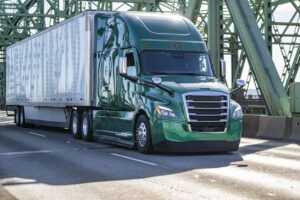HARTFORD, Conn. — Hundreds of people turned out Wednesday for a legislative hearing Wednesday on whether Connecticut should institute electronic highway tolls, highlighting the strong divide that’s developed over an issue being pushed hard by the state’s new Democratic governor.
Many proponents wore green stickers touting how an estimated 40 percent of the estimated tolling revenue would come from out-of-state drivers, while unionized operators of construction equipment handed out T-shirts that read “Fund Our Roads.” Some opponents stood outside the hearing room holding handmade signs and encouraging people to sign a petition they say have surpassed 53,000 signatures.
“I look at it this way. They’re in a race. We’re in a race,” said tolls opponent Jen Ezzell of Lisbon, who held a sign that read: “Not One Penny More.” She said it’s a “crapshoot” as to which side will win the battle this session.
“If we can get them out there, we have a good chance of stopping this,” she said of her fellow opponents. “But if they get ahead of us and they get their votes that they need, then they’re going to win.”
John Daddona, apprentice coordinator at the International Union of Operating Engineers, Local 478, said people don’t like tolls, but the message is getting across that Connecticut needs a new source of transportation revenue.
“The tolls are the fairest way. Nobody wants to pay taxes,” he said. “But at least the people who use them now are paying for what they’re using.”
Electronic tolling has become one of the hottest battles of this year’s legislative session. The General Assembly’s Transportation Committee was the first to take up the issue, holding a lengthy hearing Wednesday on two bills, including one proposed by Democratic Gov. Ned Lamont that could lead to about 52 gantries on approximately 330 miles of roadway along Interstates 91, 95, 84 and Route 15.
Lamont began the morning by releasing a video on social media, arguing that toll revenue is vitally needed to “speed up our transportation system” and to “get this state moving again” economically. He also appeared at a news conference with business leaders who warned how the lack of infrastructure improvements is hurting the state. The state’s main transportation account, which relies heavily on gas tax revenue, is projected to be insolvent by 2024.
“Look, it’s tough,” he said. “I hate to say, we’ve got to pay our bills. And we haven’t done that in this state. We’ve been putting everything on the credit card … and that’s what’s gotten us into the situation we’re in today.”
Lamont, who campaigned on imposing tolls only on big trucks, offered two options in his budget proposal: tolling trucks or tolling all vehicles. But he has made it clear he prefers more widespread tolls , which are estimated to eventually generate $800 million annually after covering about $213 million in startup costs. Truck-only tolls are predicted to generate about $200 million annually.
Tolling has been estimated to begin in 2023. Even if the legislature approves tolling, Connecticut will still need federal approval.
Lamont’s tolling plan is currently a “starting point for a discussion,” said Office of Policy and Management Secretary Melissa McCaw.
Some lawmakers raised concerns about how the 52 gantries would be located six miles apart, noting there are only 13 tolls over 138 miles of the Massachusetts Turnpike. Department of Transportation Commissioner Joseph Giuletti said there’s a greater distance between exits on the Mass Pike and Lamont’s plan attempts to address drivers who want to bypass tolls by using local roads. But Giuletti acknowledged the distance between gantries could be changed. He also promised to provide lawmakers with an estimated cost for the average Connecticut driver, after accounting for discounts. A DOT study suggested charging 4.4 cents per mile during peak hours for passenger vehicles and 3.5 cents per miles during off-peak hours.
The Associated Press is an independent global news organization dedicated to factual reporting. Founded in 1846, AP today remains the most trusted source of fast, accurate, unbiased news in all formats and the essential provider of the technology and services vital to the news business. The Trucker Media Group is subscriber of The Associated Press has been granted the license to use this content on TheTrucker.com and The Trucker newspaper in accordance with its Content License Agreement with The Associated Press.







